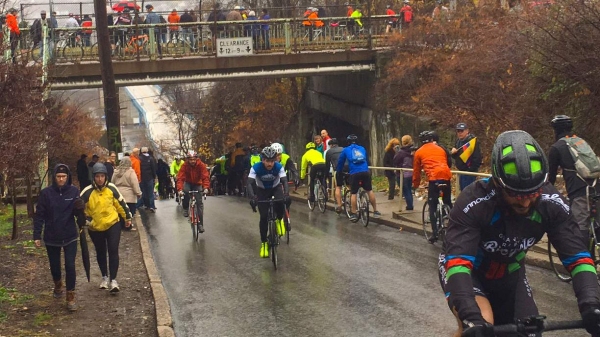
On October 25, a small group of protesters blocked Second Avenue outside of the Allegheny County Jail, protesting the housing of trans-women inmates in the male population inside the jail.
You can look at the Post-Gazette video and see that the protestors are diverse: black, white, men, women.
According to the Trib-Review, 11 protestors were arrested for blocking the street. Ten were released and continued protesting on the sidewalk; the 11th was held in custody. Quick-and-dirty summary: people blocked a street for a peaceful protest and got arrested.
Now let's talk about the Dirty Dozen, which is an annual slice of the Most Liveable Burgh that takes place just after Thanksgiving (Nov.24th this year).

Cyclists race up the 13 steepest streets in the Metro area - some inside Pittsburgh, some outside Pittsburgh. There's a small nucleus of actual racers, a large complement of enthusiasts who want to ride the hills, and a large number of people who come out to stand on the sidewalks and cheer them on. This is, with few exceptions, a White People Thing. This is a First Pittsburgh event.
The Dirty Dozen relies on squads of volunteers to block the streets the cyclists will compete on. Each street is closed for about forty-five minutes. No permits, no police, no authorities - just people with flags saying, the road is closed for the Dirty Dozen. These are key roads that connect the peaks to the river bottoms. People are delayed and inconvenienced.

The Dirty Dozen is primarily a white male activity. The leadership group is white.
Why do we treat these two groups so differently?
Why can the Dirty Dozen travel around the Metro region, closing streets as they will, and be recognized as one of the quirky things that makes Pittsburgh Most Livable? Why are the people who protest caging transwomen prisoners in the male population at the County Jail arrested for blocking a street?
Smells like White Privilege. Smells like Two Pittsburghs.



1 comments:
Just reporting, the Dirty Dozen organizers got tired of 911 calls called on the rider on the road and confrontations between volunteers and the police (as well as the public). So this year (2018), they reorganized the event into small groups obeying traffic laws so there were no ad hoc or illegal street closures. Also just reporting, there was a perhaps a 5 year period in which the DD period when the DD was in the 'awkward' stage (taking the 5th amendment here for all volunteers) stage when all participants couldn't get through a single traffic light cycle, and interactions with citizens and police escalated. I don't dispute your premise, but confrontations with the Station 5 police over the unlicensed use of the oval parking lot in 2017 still was enough to convince the organizers to never try that again.
Post a Comment
Comments and Feedback? Love that stuff. Please leave your thoughts in the box below--